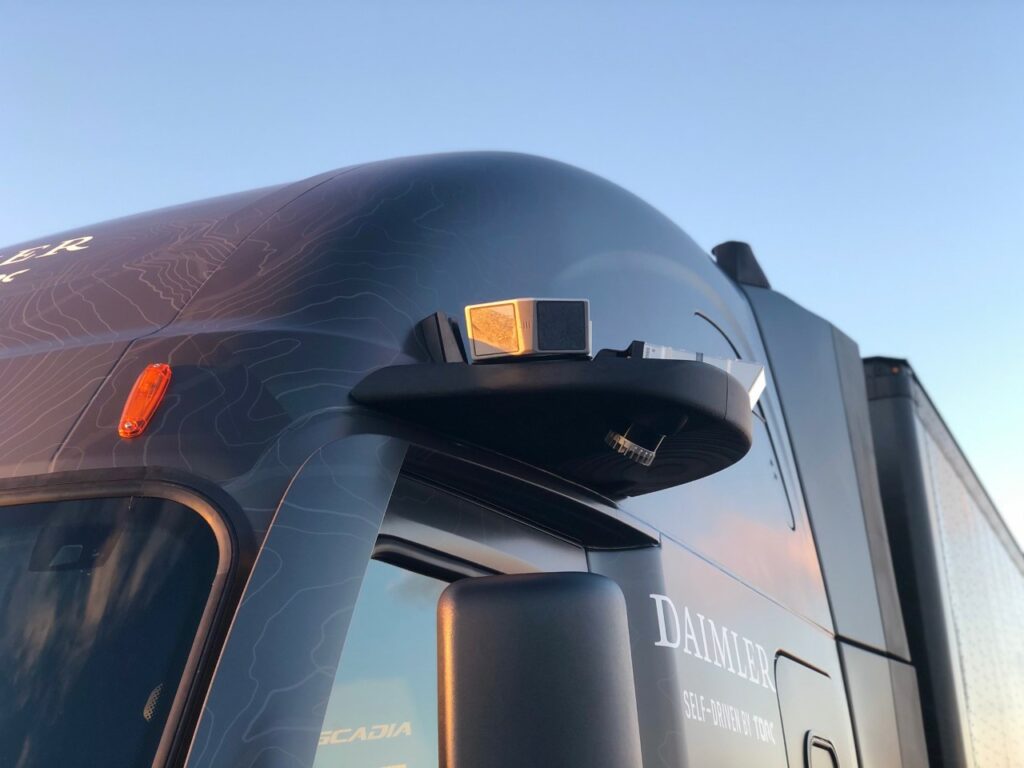The A-Z story of truck safety
Evolving safety systems and programs ensure that tractor-trailers are safer than ever. But what do you know about the underlying technology and history? Here’s the A-Z story of truck safety, highlighting major advances that help keep trucks between the lines.
ABS – Antilock Braking Systems (ABS) have been mandated on tractors manufactured since March 1997 and trailers made since March 1998. The systems monitor rotating wheels and will automatically release and reapply brakes to help keep wheels from locking up. Hence the name. This helps drivers stay on their intended paths and prevent jackknifes.

BRAKES – George Westinghouse invented the first air brakes for rail cars in 1869. They remain a favored control system for today’s tractor-trailer brakes because, unlike hydraulic systems, air brakes can compensate for minor leaks in brake lines. The Westinghouse Air Brake Company became more widely known as WABCO and was sold to ZF in 2019.
CONSPICUITY MARKINGS – Do trailer edges sparkle when illuminated by your headlights? Thank conspicuity markings. U.S. regulators were the first to require trailers to be marked with reflective tape or reflectors, applying rules to equipment made as of January 1993. Transport Canada followed suit with trailers manufactured after January 1997.

DISC BRAKES – Disc brakes have been available to North America’s trucking industry since the 1980s, although early components faced performance and durability challenges. But the latest generation of equipment helped manufacturers meet rules for reduced maximum stopping distances applied to Class 8 trucks beginning in 2011. Unlike drum brakes, disc brakes are not prone to “fading” when overheating, either.
EBS – Electronic braking systems (EBS) – often referred to as “drive-by-wire” technology – emerged in Europe in the mid-1990s, providing more precise controls than air-based systems. The interest in such systems for North America is increasing with the advent of advanced driver assistance systems (ADAS) and electric-powered vehicles.

FORWARD COLLISION WARNING SYSTEMS – The emerging generation of advanced driver assistance systems (ADAS) began with forward collision warning systems. In addition to tracking vehicle speed, the technology measures the gaps between vehicles by using radar, cameras, or laser-based Lidar systems – and sometimes a combination of them – and triggers audible alarms or lights to alert drivers if following distances shrink too rapidly.
GRADE SENSORS – An object at rest naturally wants to roll back down a hill, at least when that object is a truck stopped on an incline. Hill start assist systems use grade sensors to detect such inclines, holding equipment in place as the brake pedal is released and before the driveline has a chance to engage. This reduces the driveline damage associated with shock loads and reduces the danger of rolling back into a vehicle tucked behind a trailer.
HOURS OF SERVICE – Canada’s federally regulated truck drivers were first required to track their hours of service in logbooks in 1988, after the for-hire trucking industry was deregulated through the Motor Vehicle Transport Act. The drivers will be required to track their hours using independently certified electronic logging devices (ELDs) by January 2023.

INSPECTIONS – The Commercial Vehicle Safety Alliance (CVSA) was established in 1980 by state and provincial agencies responsible for commercial motor vehicle enforcement. Its first out-of-service criteria for commercial vehicles, established by what was then the Western States Commercial Vehicle Safety Alliance, was adopted by seven U.S. states and two provinces.
J1939 – Trucks have included electronic systems since the 1980s, but they can share information thanks to the Society of Engineers (SAE) standard that governs communication protocols. Initially released in 1994, the J1939 standard establishes a framework for electronic control units (the microprocessors associated with individual systems) so they can communicate with one another.
KNOWLEDGE – As far as highway safety has come, there is still much to do. The U.S. Federal Motor Carrier Safety Administration (FMCSA) saw the number of large trucks involved in fatal crashes increase 2% from 2018-19, and the fatal crashes per 100 million miles increased 4%. The number of large trucks involved in injury crashes rose 6%.

LEVELS OF AUTONOMY – The journey to autonomous trucks is less about “driverless” trucks than it is about automated safety systems like automated emergency braking, lane departure systems, and collision avoidance systems. In 2014, the Society of Automotive Engineers (SAE) established a scale of 0-5 to clearly define the levels of automation.
MULTIPLEXING – One of the biggest challenges to mandating antilock brakes came in a call to develop in-dash warning lamps. North America’s trucking industry showed little interest in adopting a second connector between tractors and trailers to make that happen. The solution came in the form of multiplexing, carrying multiple signals for different devices along a common wire, hitching a ride much like the beads of water on a fishing line.
NATIONAL SAFETY CODE – Canada’s trucking regulations are largely provincial and territorial responsibilities. But the National Safety Code (NSC) identifies areas where common ground can be found around minimum performance standards. There are 16 standards covering everything from driver medicals, to out-of-service criteria, hours of service, cargo securement standards, and more.
OCCUPATIONAL HEALTH AND SAFETY REGULATIONS – Canada’s Industrial Safety Act emerged in 1964, and defined safety as the “freedom from injury to the body or freedom from damage to health.” It emerged following a Royal Commission that investigated the Hogg’s Hollow Disaster, in which five Italian-born workers were killed while establishing a water main tunnel under the Ontario’s Don River.

PLACARDS – What you don’t know can kill you. This is especially true when a trailer carries dangerous goods. But standardized diamond-shaped placards identify the contents. Canada began developing Transportation of Dangerous Goods (TDG) regulations in the early 1980s, and the first complete set of rules took hold in 1985.
QUALIFICATIONS – It would be difficult to apply safety-related rules if you didn’t identify vehicles and their drivers. Ontario issued Canada’s first licence plates (made of leather) in 1903, and Leonard S. Meiler is credited as the holder of the province’s first commercial licence, issued in 1927.
RADAR – Radar sensors play a central role in collision mitigation systems, identifying the proximity to a hazard. One of the first warning systems to employ such sensors was Eaton’s Vorad equipment, introduced in 1992. While radar is effective at spotting metallic objects such as cars, regardless of visibility, today’s collision mitigation systems often incorporate additional sensors such as cameras that are more effective at spotting things like pedestrians.

SEATBELTS – Volvo engineer Nils Bohlin invented the three-point safety belt in 1959, making the restraints undeniably more effective and easier to use. While the OEM patented its design, they freely gave it to competitors to ensure broader use. Not everyone uses them, though. In 2019, 13% of the large truck occupants involved in fatal crashes were not wearing safety belts, and 42% of them died, FMCSA says. But just 8% of the truck drivers who were wearing safety belts were killed.
TRAINING – Truck driver training is ultimately a provincial responsibility, but in 2020 Canada’s transportation and highway safety ministers committed to establishing a basic threshold that students would have to meet before taking a road test. That mandatory entry-level training requires at least 103.5 hours of training for a Class 1 licence, 50 hours of which are in a cab. Air brakes require another 8.5 hours of training. Schools continue to exploit loopholes, and critics argue the training does not go far enough, but it represents one of the first bids to establish a baseline.

UNDERRIDE GUARDS – Canadian rules require trailer underride guards to absorb four times more energy than those in the U.S. Thank our love of smaller cars. Transport Canada noted in the mid-1990s that existing underride guards would fail to protect occupants in a Chevy Cavalier or Honda Civic at 48 km/h. Stronger designs emerged through engineering work by the Canadian Transportation Equipment Association and National Research Council.
VIDEO – Robert Surgenor, an officer with the Berea Ohio police department, is widely credited for recording the first high-speed police chase from beginning to end. That 1988 recording was made with a video camera he installed on the dashboard of his cruiser. These days, video-based monitoring systems trigger recordings based on factors such as hard braking events – offering details that can be used to coach drivers or investigate collisions. Driver-facing models even identify distracting activities such as cell phone use.
WINDSHIELD WIPERS – The next time you’re driving through the rain, give a thankful thought to Mary Anderson, who filed the first patent for a windshield wiper. The idea came to her in 1902 as she watched a streetcar operator struggle to remove snow from his windshield. The National Inventors Hall of Fame member from Birmingham, Alabama, was awarded a patent in 1903 for a “window cleaning device” that could be operated by a lever inside the vehicle. The first patent expired in 1920 after she gave up trying to find companies interested in producing her invention.

X-FACTOR – One factor that increases the likelihood and severity of collisions is in the form of speed. This is driving discussions about mandating speed limiters in the U.S. The FMCSA says about 20% of fatal commercial motor vehicle crashes happen in areas with posted speeds of 70-85 mph (about 110-135 km/h). Ontario and Quebec have mandated speed limiters set at 105 km/h since 2009.
YAW RATE – Canada began phasing in electronic stability controls in 2017, introducing tools that would help to tackle roughly 660 truck rollovers per year. The systems automatically reduce engine torque and engage engine retarders, helping drivers to maintain control during emergency maneuvers or when cornering on slippery services. From 2005 to 2012, Canada recorded was an annual average of 2,810 tractor collisions that included a rollover or loss of control leading up to the event.
(Vision) ZERO – Sweden’s Vision Zero program, launched in 1997, committed to eliminating death and serious injuries from roads. Within two decades the nation cut the number of traffic deaths in half. Similar commitments have been adopted by countries including Canada.
Have your say
This is a moderated forum. Comments will no longer be published unless they are accompanied by a first and last name and a verifiable email address. (Today's Trucking will not publish or share the email address.) Profane language and content deemed to be libelous, racist, or threatening in nature will not be published under any circumstances.
Mr. Smith,
Good Morning
I was reading your article about air brake system. under MELT program the air brake course for tractor-trailers according MTO IS 12 HOURS IN CLASS AND PRACTICLE. But YOUR ARTICLE was showing 8.5 hours, in truck news, which was incorrect.
Thanks.